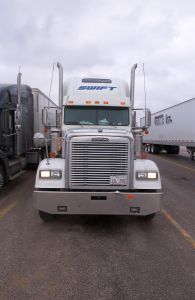- Free Initial Consultation: (954) 761-3641 Tap Here To Call Us
Truck Accident Victim’s Daughters Win $35M Wrongful Death Verdict
It’s estimated there are approximately 15.5 million large trucks operating in the U.S., including about 2 million tractor-trailers. There are more than 1 million trucking companies and an estimated 3.5 million truck drivers. There is ample opportunity for something to go wrong, and that’s a serious problem when we’re talking about such massive vehicles sharing the roadway with smaller, vulnerable passenger vehicles.

One of those who was unfortunate enough to cross paths with a negligent truck driver was 42-year-old Velma Dismukes. She was a single mother of three girls, ranging in age from 15 to 26. She was employed as a hospice nurse in Texas and she set out one February morning in 2015 to check in on a patient at home. The roads were icy. She took it slow. Unfortunately, the semi-truck that careened into her lane was not.
According to DallasNews.com, the driver picked up the rig from the terminal that morning, set to deliver office supplies from Dallas to a smaller suburb about an hour away. He was well aware of the condition of the roads because he drove himself to the terminal. Nonetheless, he failed to install snow chains on his vehicle. This proved a deadly mistake.more
Now many who reside here in Fort Lauderale are probably familiar with snow chains, unless you’re originally from up north. Snow chains are devices that can be placed on the tire of a vehicle – often trucks, but not always – that allow the vehicle greater traction and control on roads that are snowy and icy. The downside – and the reason they are discouraged by so many trucking companies – is that they slow the vehicle down. In some cases, trucks can’t go much higher than 50 mph. That sounds like snail’s pace on the highway, but the fact is, when the conditions are that bad outside, drivers – especially those operating large commercial vehicles – shouldn’t be traveling much faster than that anyway.
Evidence at trial would reveal the truck company had the snow chains available at the terminal, but the driver either didn’t know that or wasn’t trained to use them. Plaintiff’s attorney would later argue the driver should have decided to put off the drive until the weather got better and should never have been out on the roads that morning to begin with.
At some point during the drive, the trucker lost control of the rig and slid into plaintiff’s lane, head-on. He crashed into Dismuke’s car, killing her in an instant. The 56-year-old driver of the 18-wheeler was also reportedly injured in the truck accident. However, he did ultimately survive and likely was able to collect workers’ compensation payments, as he’d been on-the-job at the time of the crash and workers’ compensation is a no-fault system of benefits for work-related injuries.
It’s unclear whether Dismuke’s children were able to collect workers’ compensation death benefits because of the coming-and-going rule. Generally, workers commuting to and from a job aren’t entitled to workers’ compensation benefits. However in this case, she was traveling to someone’s home and depending on the circumstances, there could be a case made for benefits here.
In either case, her daughters filed a lawsuit against the trucking company and the driver, alleging negligence, vicarious liability and more. Jurors sided with plaintiffs, awarding $35 million, with 90 percent of that to be paid by the trucking company.
Truck accident lawsuits in Florida can be complex and high stakes. We can help.
Call Fort Lauderdale Injury Attorney Richard Ansara at (954) 761-4011. Serving Broward, Miami-Dade and Palm Beach counties.
Additional Resources:
Jury awards $35M to family of hospice nurse killed in icy crash with 18-wheeler, Sept. 7, 2016, DallasNews.com
More Blog Entries:
Jorge v. Culinary Inst. of Am. – Vicarious Liability of Employer for Car Accident, June 25, 2016, Fort Lauderdale Truck Accident Lawyer Blog













